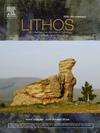乍得南部多巴盆地新近新生代晚期花岗岩岩浆活动:对非洲中北部地壳演化的影响
IF 2.9
2区 地球科学
Q2 GEOCHEMISTRY & GEOPHYSICS
引用次数: 0
摘要
本文章由计算机程序翻译,如有差异,请以英文原文为准。
Late Neoproterozoic granitic magmatism in the Doba Basin of Southern Chad: Implications for the crustal evolution of North-Central Africa
The Doba Basin is one of four oil producing basins of southern Chad that developed within the West and Central Africa Rift System during the Late Cretaceous opening of the Central Atlantic Ocean. The Cretaceous basins were built upon older Ediacaran basins that formed after the collision between the Congo-São Francisco Craton and the continental crust of North-Central Africa. Oil exploration drill wells in the Doba Basin (Mouroumar-1, Benoy-W2, Kiagor-1, Djabi-1, Bebalem-1) encountered granitic rocks at depths from 2250 m to 3230 m. The granitic rocks were dated by zircon U![]() Pb methods and yielded ages of 594 ± 4.4 Ma (Benoy), 594 ± 4.2 Ma (Kiagor), 595 ± 4.3 Ma (Bebalem), and 579 ± 4.1 Ma (Mouroumar). The older granitoids are magnesian and metaluminous to weakly peraluminous, and compositionally similar to volcanic-arc granites. The younger granites are magnesian to ferroan and classify as within-plate or post-collisional granite. The magmatic zircon Hf isotopes (εHf(t) = −12.5 to 0.0) and whole rock Nd isotopes (εNd(t) = −3.3 to −8.2) show that all granitoids were derived from an isotopically enriched source. Crystallization pressure estimates from biotite and titanite indicate that they were emplaced in the upper crust (1–4 kbar). The volcanic-arc granitoids likely had lower parental magma temperatures (∼800 °C) than the post-collisional granitoid (∼900 °C). The results from this study along with previously published results demonstrate that contemporaneous (620–590 Ma) volcanic-arc magmatism stretched 1000–1500 km from the Doba Basin through the Guéra Massif to the Ouaddaï Massif and was followed by post-collisional magmatism at ≤580 Ma. The implication is that the southeastern and eastern portions of the Saharan Metacraton were not structurally contiguous with the western and northwestern portions until after ∼590 Ma. Consequently, the continental crust of North-Central Africa is not a coherent craton, but rather it is a composite shield terrane similar to the Arabian Nubian Shield or Central Asian Orogenic Belt.
Pb methods and yielded ages of 594 ± 4.4 Ma (Benoy), 594 ± 4.2 Ma (Kiagor), 595 ± 4.3 Ma (Bebalem), and 579 ± 4.1 Ma (Mouroumar). The older granitoids are magnesian and metaluminous to weakly peraluminous, and compositionally similar to volcanic-arc granites. The younger granites are magnesian to ferroan and classify as within-plate or post-collisional granite. The magmatic zircon Hf isotopes (εHf(t) = −12.5 to 0.0) and whole rock Nd isotopes (εNd(t) = −3.3 to −8.2) show that all granitoids were derived from an isotopically enriched source. Crystallization pressure estimates from biotite and titanite indicate that they were emplaced in the upper crust (1–4 kbar). The volcanic-arc granitoids likely had lower parental magma temperatures (∼800 °C) than the post-collisional granitoid (∼900 °C). The results from this study along with previously published results demonstrate that contemporaneous (620–590 Ma) volcanic-arc magmatism stretched 1000–1500 km from the Doba Basin through the Guéra Massif to the Ouaddaï Massif and was followed by post-collisional magmatism at ≤580 Ma. The implication is that the southeastern and eastern portions of the Saharan Metacraton were not structurally contiguous with the western and northwestern portions until after ∼590 Ma. Consequently, the continental crust of North-Central Africa is not a coherent craton, but rather it is a composite shield terrane similar to the Arabian Nubian Shield or Central Asian Orogenic Belt.
求助全文
通过发布文献求助,成功后即可免费获取论文全文。
去求助
来源期刊

Lithos
地学-地球化学与地球物理
CiteScore
6.80
自引率
11.40%
发文量
286
审稿时长
3.5 months
期刊介绍:
Lithos publishes original research papers on the petrology, geochemistry and petrogenesis of igneous and metamorphic rocks. Papers on mineralogy/mineral physics related to petrology and petrogenetic problems are also welcomed.
 求助内容:
求助内容: 应助结果提醒方式:
应助结果提醒方式:


